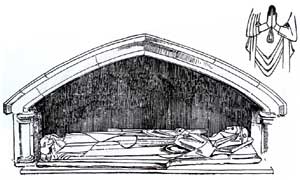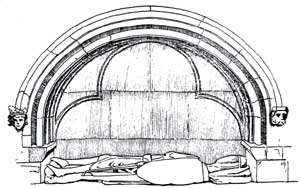The north transept has a recess for founder’s tomb flanked by an aumbry
with a fine arched head under a hood mould stopped with masks. It has
a rebated door casement and is grooved for two shelves. On the floor of
the tomb recess is a fragment of some recumbent effigy, the loose

Effigy of a lady in south wall of nave, Norwell Church, Notts.
In the south wall of the nave is an Early English arched recess with
detached jamb-shafts, beneath which lies the recumbent effigy in
The south transept, in which we are told was the chapel of the Blessed Virgin Mary, is now used as a vestry, and is entered through a pointed arch of two orders with plain chamfers and surmounted by a hood mould on the inner side. This arch is supported on responds composed of circular shafts almost detached, with a good example of the keel-pattern fillet, which is continued over the neck mould of the capitals. The architecture of this and of the arched recess to the founder’s tomb within the transept, is so similar to that of the south transept at Egmanton that one concludes that both are the work of the same master-mason. The transept is lit by square-headed south and east windows of three lights.
There is a piscina with credence shelf above, under a trefoil-headed arch with square hood mould resting on masked stops. In one of the spandrils will be noticed the fat face of a bearded gentlemen with deep clean shaven upper lip, luxuriantly curled beard and large flopping asses ears—possibly lampooning some politician or Pooh Bah of the period. The piscina has a foliated drain of eight lobes with projecting basin, the front stone of which, however, is a "restoration."

Founder's tomb in South Transept, Norwell church, Notts.
In the south wall is the founder’s tomb beneath a fine semi-circular arch with bold hood mould supported on a crowned head at its eastern terminal and a moustachioed head which looks like a 19th century "restoration" at its western end, Beneath the hood mould the arch is deeply moulded, with the keeled fillet along the roll which forms its first order. The wall of the recess is broken into a trefoil panel by graceful filletting.
The figure below is the
Other monuments in this transept are worth notice. The large alabaster one with heraldic achievements on the west wall has a slate panel with a long curiously worded Latin inscription to Elizabeth, daughter of Sir William Ayloffe and wife of Gervase, son of Gervase Lee, Esquire, with whom it states she lived for twice eight years and blessed with twice eight children, of either sex an equal number, and after such a well-balanced existence died, in the eager hope of resurrection, on 4th April, 1629. Below the east window is a brass plate dated 1658 to Edward Dallowe of Norwell Woodhouse and Anne his wife, with their impaled arms nicely incised above. In the floor is a large alabaster slab deeply carved with the Lee arms and there are later slabs to John Townsend, Vicar, who died 20th July, 1749; Edward Walker, Vicar, who died 10th August, 1797; and several memorials of the Hutton family. On a tablet on the east wall is commemorated Thomas Sturtevant, "who was the last of the family of that name at Palace Hall." He died 1772, aged 87.
The Parish Registers unfortunately do not begin until 1684. The marriages therein have been printed in Phillimore’s Series, Vol XX. Norwell was naturally within the peculiar jurisdiction of Southwell and the wills of the inhabitants were all proved at that court until the abolition of ecclesiastical probate jurisdiction in 1858. The particulars for marriage licences will also, of course, be found at Southwell for this parish. They are now being printed by the British Record Society.
The church plate is noteworthy. It comprises, chiefly, a chalice eight inches high with brim four inches in diameter, with ring on stem. It has no inscription and the date mark is worn away.
There is a fine flagon of sixty-eight ounces, and the date letter for
1733. It has a low domed lid and flanged base and a scroll handle with
thumb piece. It is inscribed, "The gift of Thomas Sturtivant of Pallis
Hall,
The Esams were related to the Sturtivants, with whom they intermarried more than once.
The flagon and silver collecting saucepan are of similar type to those
in the Leake plate at
"The gift of Mrs. Marie Wilkinson 1729/30" and with the date letter for 1729.
In the churchyard should be noticed a fine coffinshaped grave cover
of the 13th century with foliated headed cross and calvary base. It lies
just outside the south porch. There are one or two other medieval grave
covers in the churchyard, and almost as worthy of notice because of their
excessive rarity, two headstones of the 17th century. These are in sandstone
and stand by the pathway leading directly away from the porch. They commemorate
Henry Taylor who died
18th century are to be found in Nottinghamshire, and such as there are are mostly in Swithland green slate in the parishes on the Leicestershire border. That was a far more durable material for lettering than sandstone.
The church has a scratch dial on the south-west buttress of the south transept.
I have not been into the belfry, so can tell you nothing about the bells. An omission for which I excuse myself on the ground that they will be adequately dealt with in the excellent series of articles which the Rev. R. F. Wilkinson is contributing to our Transactions.
Those interested in the treatment of damp walls may like to have their attention drawn to the very ingenious arrangement by which the wall is both ventilated and drained, introduced into the wall at the east end of the south aisle by the generosity of Mrs. Hole of Caunton who had observed it in Belgium.
.